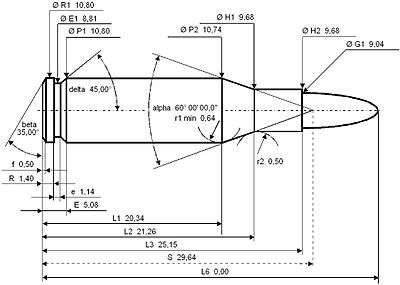9×25mm Dillon
| 9×25mm Dillon | ||||||||||||||||||||||||
|---|---|---|---|---|---|---|---|---|---|---|---|---|---|---|---|---|---|---|---|---|---|---|---|---|
| Type | Pistol | |||||||||||||||||||||||
| Place of origin | United States | |||||||||||||||||||||||
| Production history | ||||||||||||||||||||||||
| Designer | Dillon Precision | |||||||||||||||||||||||
| Designed | 1988 | |||||||||||||||||||||||
| Specifications | ||||||||||||||||||||||||
| Parent case | 10mm Auto | |||||||||||||||||||||||
| Case type | Rimless, bottleneck | |||||||||||||||||||||||
| Bullet diameter | .356 in (9.0 mm) | |||||||||||||||||||||||
| Neck diameter | .380 in (9.7 mm) | |||||||||||||||||||||||
| Shoulder diameter | .423 in (10.7 mm) | |||||||||||||||||||||||
| Base diameter | .425 in (10.8 mm) | |||||||||||||||||||||||
| Rim diameter | .425 in (10.8 mm) | |||||||||||||||||||||||
| Rim thickness | .0550 in (1.40 mm) | |||||||||||||||||||||||
| Case length | .990 in (25.1 mm) | |||||||||||||||||||||||
| Overall length | 1.250 in (31.8 mm) | |||||||||||||||||||||||
| Case capacity | 22.8 gr H2O (1.48 cm3) | |||||||||||||||||||||||
| Rifling twist | 1 in 16" (406 mm) | |||||||||||||||||||||||
| Primer type | Center-fire large pistol | |||||||||||||||||||||||
| Maximum pressure | 36,259 psi (250.00 MPa) | |||||||||||||||||||||||
| Ballistic performance | ||||||||||||||||||||||||
| ||||||||||||||||||||||||
|
Test barrel length: 6" (Lone Wolf SS 1:16" twist) Source(s): DoubleTap Ammunition products page | ||||||||||||||||||||||||
The 9×25mm Dillon is a pistol wildcat cartridge developed for use in USPSA/IPSC Open guns. The cartridge is made by necking down a 10mm Auto case to 9 mm.
History
Around 1987, Randy Shelley, an employee of Dillon Precision, necked down 10mm auto brass to 9mm. His goal was to get as much slow-burning powder in the case as possible in order to drive a 9mm bullet to the velocity needed to qualify for the then IPSC Major power factor of 175. The short-necked and steep-shouldered cartridge holds twice the powder of a .38 Super Auto case.[1]
The 9×25mm Dillon was used by several notable IPSC shooters, such as Rob Leatham and Jack Barnes.[2] Leatham developed loads with less blast and shock to mitigate this, but discovered there was little advantage over a similar load in .38 Super.[3]
Most shooters, looking at the 9×25mm Dillon today, focus on the extreme velocities it is capable of. A 115 grain bullet at 1800 fps is impressive, but more than needed for competition. There, a 115 only needed to be going a bit over 1500 fps to make Major. What competitors in the late 1980s and early 1990s who were using the 9×25mm Dillon were doing was adjusting the powder used, to produce more pressure in the compensator, or muzzle brake. A muzzle brake works by diverting gases to reduce felt recoil. the greater the gas volume, or the pressure that gas is at, the more force the comp or brake creates. Competitors could "feed" the comp more gases. This turned out to be too much of a good thing. The muzzle blast created by the combination proved to be tiring over the course of a match. And the resulting recoil re-direction proved hard on elbows and shoulders.
What finally put an end to the 9×25mm Dillon in competition was component wear, magazine capacity and lowering of the USPSA Major power factor from 175 to 165 (160 for IPSC competition). Barrels and compensators in high-pressure cartridges like .38 Super at Major velocities have a much shorter service life than lower-pressure ones. For maximum-permitted length magazines as used in USPSA/IPSC competition, a .38 Super magazine holds more rounds than a 9×25mm Dillon magazine. With the lowering of the USPSA power factor, safety and effectiveness of .38 Super loads improved to a point that the 9×25mm Dillon was no longer competitive and once worn out, pistols were often retired or rebuilt in .38 Super.
Cartridge dimensions
The 9×25mm Dillon has 1.48 ml (22.8 grains) H2O cartridge case capacity.

9×25mm Dillon maximum cartridge dimensions.[4] All sizes in millimeters (mm).
Americans would define the shoulder angle at alpha/2 = 30 degrees. The common rifling twist rate for this cartridge is 406 mm (1 in 16 in), 6 grooves, Ø lands = 8.79 mm, Ø grooves = 9.02 mm, land width = 3.07 mm and the primer type is large pistol.
According to the QuickLOAD database the 9x25mm Dillon case can handle up to 250 MPa (36,259 psi) piezo pressure. Since there are no C.I.P. or SAAMI limits and data sets for wildcat cartridges this data has to be regarded with caution.
The Austrian 9×25mm Super Auto G pistol cartridge is probably the closest ballistic twin of the 9×25mm Dillon. These cartridges are both necked down 9 mm variants of the 10 mm Auto cartridge though they dimensionally vary.
Reloading
Making the 9×25mm Dillon is fairly easy. Dillon Precision makes the necessary resizing die and reliable reloading data is easily found. Most people were using 115 grain bullets, but bullets with weights as low as 80 grains were used too.
Commercial availability
Loaded cartridges: As of 2016, DoubleTap offers six 9×25mm Dillon factory ammunition loads from 80 to 180 grains.[5] Underwood Ammo offers three 9×25mm Dillon factory ammunition loads from 90 to 125 grains.[6]
Conversions: Drop-in barrels are available as aftermarket parts for the Glock 20 and Glock 29 semi-automatic pistols.[7] These pistols are originally chambered by Glock for parent cartridge of the 9×25mm Dillon, the 10mm Auto.
See also
References
- ↑ Marshall and Sanow, Street Stoppers, p. 139, Paladin 2006
- ↑ "The IPSC Dream Team: Champion Guns and Gear" (#1). 1995.
- ↑ GunGames magazine Issue 1
- ↑ QuickLOAD software suite
- ↑ DoubleTap factory loaded 9x25 Dillon ammunition
- ↑ Underwood Ammo factory loaded 9x25 Dillon ammunition
- ↑ Lone Wolf 2008-2009 Catalog
- 9x25 home page, October 7, 2001 archive accessed
- 9x25mm Dillon - 2nd Edition Lyman Pistol and Revolver Handbook, Page 91